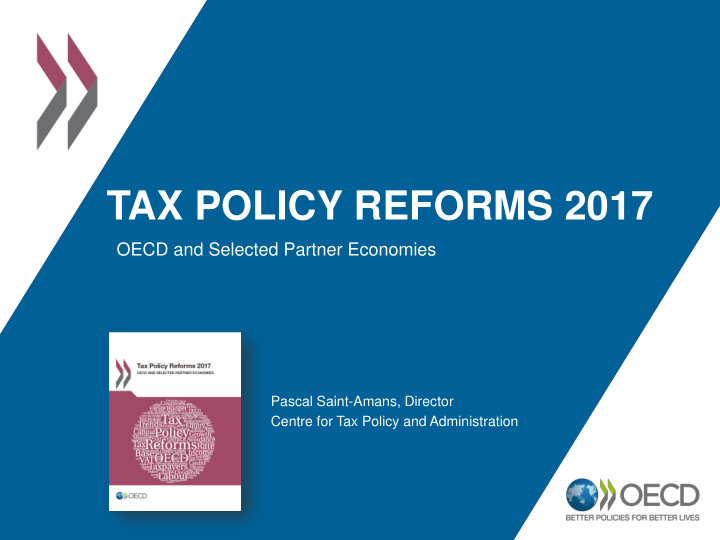



TAX POLICY REFORMS 2017 OECD and Selected Partner Economies Pascal Saint-Amans, Director Centre for Tax Policy and Administration
Second edition of Tax Policy Reforms Tax reforms implemented, legislated or announced in 2016 Coverage: OECD countries, Argentina and South Africa Next step: additional key partner countries in future editions 2
GENERAL TRENDS 3
2015: Record tax revenue levels Evolution of the OECD average tax-to-GDP ratio between 2000 and 2015 Source: OECD Revenue Statistics 4
Shift in tax reform focus in 2016: Growth and fairness Low growth Corporate taxes Weak investment Improved public Personal income budgets taxes, in particular on low and middle incomes High income inequality 5
Most comprehensive tax reforms in 2016 COUNTRIES THAT UNDERTOOK MAJOR TAX REFORMS Almost all EU countries • Austria Belgium Greece Hungary Large countries missing • Luxembourg The Netherlands Norway 6
Increased international co-operation Implementation of BEPS measures within the Inclusive • Framework Continued co-operation on the exchange of information for • tax purposes Widespread implementation of the International VAT/GST • Guidelines 7
OVERVIEW OF TAX-BY-TAX TRENDS 8
Labour taxes have been a major and increasing source of revenues Breakdown of OECD tax revenues – average 2007 2014 9 Source: OECD Revenue Statistics
Personal income taxes have been reduced in many countries Many tax reductions for low and middle income earners (e.g. AUT, BEL, CAN, ISR, LUX, SVN) Incentives to attract highly-skilled individuals (ISR, ITA and PRT) Continued tax increases on dividends and interests (BEL, FIN, GRC, LUX, NOR, SVK, SWE) No major cuts in social security contributions except BEL, HUN, ITA • 10
But overall effects on tax wedges are expected to be small Evolution of the average tax wedge in the OECD between 2000 and 2016 Source: OECD Taxing Wages Database 11
CIT rates have been falling, but less so in recent years Evolution of the average statutory CIT rates and CIT revenues in the OECD 12 Source: Tax Policy Reforms 2017
Competition on corporate tax rates is intensifying again Changes to central statutory CIT rates implemented or legislated in 2016 Source: Tax Policy Reforms 2017 13
In parallel, efforts have been made to broaden corporate tax bases The implementation of BEPS-counter measures continued • Domestic base broadening, in particular restrictions to loss carryover • provisions (ESP, GBR, JPN, KOR, LUX, LVA) Base narrowing provisions: new or enhanced tax incentives, in • particular for IP-related income or R&D (e.g. HUN, ISL, ITA, MEX, POL) 14
The trend towards increasing standard VAT rates appears to have come to an end Evolution of the average standard VAT rate in the OECD between 1975 and 2017 Source: Tax Policy Reforms 2017 15
Excise duties were raised Increased excise duties, especially on tobacco • Increasing popularity of taxes on soft drinks, new taxes in BEL and PRT • and announcements in ESP, EST, GBR, IRL and ZAF Taxes on transport fuels continued to be raised , while fuels in other • sectors remain taxed at low rates 16
Modest changes in property taxes Increases in recurrent taxes on real estate and transaction taxes • Tax increases on owners of multiple homes or buy-to-let properties to • cool housing markets (ISR, GBR) Inheritance taxes, on the other hand, were generally lowered (DNK, • IRL, FIN, GBR and NLD) 17
Questions? Send questions to Lawrence.Speer@oecd.org Follow us on Twitter @OECDtax Visit our website http://oe.cd/tax-policy-reforms 18
Recommend
More recommend